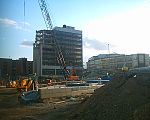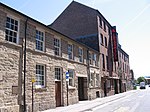National Centre for Popular Music
1999 establishments in England2000 disestablishments in EnglandBritish popular cultureBuildings and structures completed in 1999Buildings and structures in Sheffield ... and 7 more
Culture in SheffieldDefunct museums in EnglandHistory of SheffieldMusic in SheffieldMusic museums in EnglandOrganizations disestablished in 2000Use British English from April 2018

The National Centre for Popular Music was a museum in Sheffield, England, for pop and rock music and contemporary culture generally, a £15 million project largely funded with contributions from the National Lottery, which opened on 1 March 1999, and closed in June 2000. However, the plan for the centre was devised in the mid-1980s and Sheffield City Council were aiming to raise the money for it in April 1993 so the concept long predated the Tony Blair / Cool Britannia era of which it was seen as a notable failure.
Excerpt from the Wikipedia article National Centre for Popular Music (License: CC BY-SA 3.0, Authors, Images).National Centre for Popular Music
Arundel Gate, Sheffield City Centre
Geographical coordinates (GPS) Address Nearby Places Show on map
Geographical coordinates (GPS)
| Latitude | Longitude |
|---|---|
| N 53.3775 ° | E -1.466 ° |
Address
Sheffield Hallam University City Campus
Arundel Gate
S1 2FN Sheffield, City Centre
England, United Kingdom
Open on Google Maps








